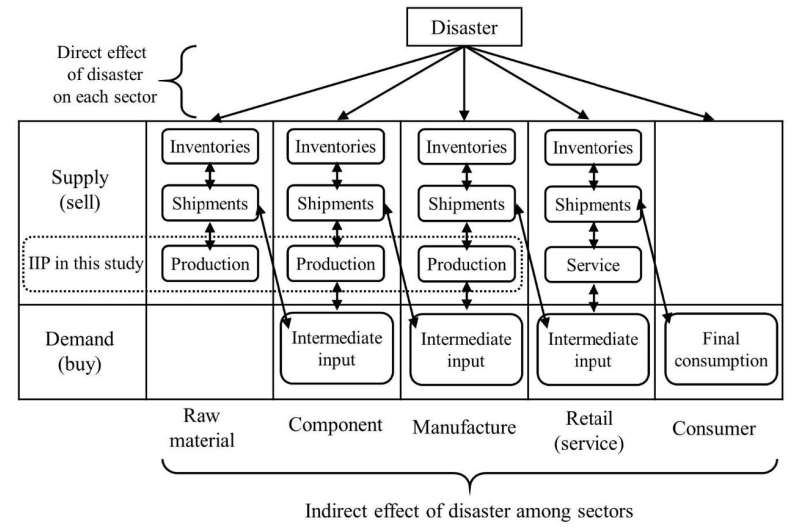Direct damage of a disaster and indirect damage among sectors in a supply chain of five sectors (as an example) Credit: John Wiley and Sons
Many people can recall shocking news images of Japan sustaining earthquake damage. Between 1996 and September of 2018, there were 155 earthquakes in Japan that resulted in human injuries. In 20 of these earthquakes, people have gone missing or were killed. During the Hyogo-ken Nanbu earthquake in 1995, 6,434 people were killed and 3 went missing. In 99 of the 155 earthquakes, damage to houses, school buildings, windows, water and sewage pipes, and landslides were recorded. Tsunamis occurred as a result of an earthquake in 18 of the 155 earthquakes.
Natural disasters cause damage to human life and also great disruption to economic activities. One of the economic activities that are effected by natural disasters are supply chains. Increasingly complex supply chains have caused risks in supply chain disruptions to also become complex, highly entangled and harder to access. Past disasters demonstrate the importance of forecasting economic damage from supply chain disruptions more accurately to structure risk-management schemes and minimize loss.
A study led by Senior Assistant Professor Michiyuki Yagi of Shinshu University used input-output analysis (IOA) to quantify economic damage associated with natural disasters; in particular, earthquakes. IOA is effective in evaluating economic impact at the regional/sectoral level. The researchers focused on the exogenous (flow) damage to focus on the monthly or quarterly levels of production statistics. They chose the Leontief price model to access the study, building on Ji Young Park (2007) that considered the supply constraint in the Ghosh price model to introduce the price elasticity of demand. This study modified Park (2007) to use the Leontief price model instead of the Ghosh price model and use the loss of social surplus as damage instead of the change in production.
The loss of social surplus was used instead of the change in production because production or sales is less informative as a damage index than profit (margin) because it can be any amount without considering profit. Production (sales) also does not identify how much damage is passed on to each supplier (upstream sector) and buyer (downstream sector).
The researchers found that previous studies' estimates of indirect damage estimation were similar to that of this study. The largest earthquakes in Japan tend to require 0.2 to 0.3 months of economic assistance for initial production immediately after the disaster within a damaged prefecture and more than 0.5 months or 50% of initial production in total until the first temporal recovery, which is the eighth month at most.
The earthquake known as the Great East Japan Earthquake required twice as much (fast) economic assistance in Fukushima, Iwate, Miyagi, Ibaraki, and Chiba prefectures. This had cumulatively, 25 month-production damage until the temporal recovery at the 37th month (to the five prefectures).
More information: Michiyuki Yagi et al, Supply Constraint from Earthquakes in Japan in Input–Output Analysis, Risk Analysis (2020). DOI: 10.1111/risa.13525
Journal information: Risk Analysis
Provided by Shinshu University























